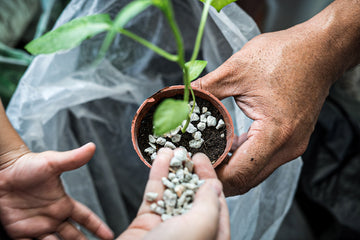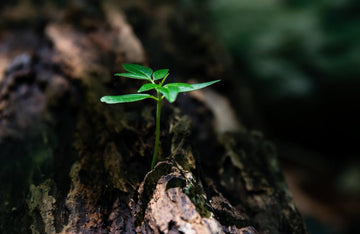How grow tents make your plants grow faster with the right nutrient media
by Marco Janssen on Nov 26, 2023

Growing plants is an art in itself, and creating the right environment plays a crucial role in this process. In this guide, we'll take a closer look at the use of grow tents and how they can help your plants grow faster, especially when combined with the right growing media.
I. Why is the optimal growing environment important?
The foundation of successful plant breeding starts with understanding the importance of the optimal growing environment. Whether you're a seasoned gardener or just starting out, the environment your plants grow in directly affects their health and productivity.
II. Benefits of Grow Tents
A. Controlled environment
Grow tents provide a controlled environment in which factors such as temperature and humidity can be precisely adjusted. This is especially beneficial for plants that require specific growing conditions.
B. Prevention of pests and diseases
One of the biggest benefits of grow tents is the protection they provide against pests and diseases. This minimizes the risk of damage to your plants, allowing them to thrive undisturbed.
C. Increased growth rate
With the right conditions inside the grow tent, plants can grow faster than in an unattended outdoor environment. This not only speeds up the growing process, but also results in healthier and stronger plants.
III. Choosing the right grow tent
A. Size Considerations
When choosing a grow tent, its size is vital. This depends on the available space and the number of plants you want to grow. A tent that is too small can hinder growth, while a tent that is too large is difficult to regulate.
B. Ventilation and airflow
Good ventilation is essential to maintain a constant airflow in the grow tent. This prevents the accumulation of heat and moisture, keeping conditions optimal for plant growth.
C. Light requirements
Different plants have different light needs. Make sure your grow tent is equipped with the right type and amount of lighting to meet the needs of your plants.
IV. The importance of nutrient-rich soils
A. Role of soil in plant growth
The soil acts as the foundation for plant growth. It provides plants with essential nutrients and stability. Grow tents offer the ability to precisely control soil conditions.
B. Types of nutrient-rich soils
Different plants require different soil types. Some thrive in well-drained soil, while others benefit from organic, nutrient-dense soils. Choose the soil that suits the needs of your specific crops.
Q. How grow tents improve plant growth
A. Regulation of temperature and humidity
One of the biggest advantages of grow tents is the ability to precisely control the environment. This includes maintaining optimal temperatures and humidity, which is essential for healthy plant growth.
B. Protection against external factors
Grow tents act as a barrier against adverse external factors such as extreme weather conditions. This provides plants with a stable environment without exposure to unpredictable elements.
VI. Choosing the right food mix
A. Understanding the nutritional needs of plants
Each plant has specific nutritional needs. Understand these needs to create a customized nutrient mix that provides essential nutrients for optimal growth.
B. Adjusting nutrients to specific plants
Different plants require different nutrients at different stages of growth. Adjust your nutrient mix based on the needs of your plants to achieve the best results.
VII. Maximum efficiency of light
A. Importance of light in plant growth
Light is one of the most important factors for photosynthesis. Make sure your grow tent is equipped with suitable grow lights to provide sufficient light for optimal growth.
B. Effective use of grow lights
Place grow lights at the correct height and angle to ensure each plant receives adequate light. This maximizes light efficiency and promotes healthy growth.
VIII. Techniques for optimal watering
A. Importance of proper watering
Water is an essential element for plant growth. Learn proper watering techniques to avoid both overwatering and underwatering, which can be harmful to your plants.
B. Techniques to Avoid Overwatering or Underwatering
Adjust watering based on the needs of your plants and the properties of the soil. Prevent water stagnation and ensure that the roots receive sufficient moisture.
IX. Common mistakes to avoid
A. Neglect of ventilation needs
A common mistake is ignoring ventilation needs. Insufficient airflow can lead to overheating and moisture problems, which is harmful to plants.
B. Insufficient attention to pH values
Soil pH levels are crucial for plant nutrient uptake. Make sure the pH levels are appropriate for your crops to avoid nutritional problems.
C. Use of incorrect lighting setups
Improper configuration of grow lights can lead to uneven lighting and growth. Adjust the light setup based on the needs of your plants.
X. Tips for Beginners
A. Start with easy-to-grow plants
For beginners it is advisable to start with plants that require little maintenance. This provides an educational experience without being overwhelmed by complex care requirements.
B. Monitoring and adjusting environmental factors
Regularly monitor environmental factors such as temperature and humidity. Adjust as necessary to maintain optimal growing conditions.
XI. Success stories from practice
A. Testimonials from successful breeders
Read and learn from the experiences of others. Success stories provide valuable insights and tips for improving your own growing practices.
B. Lessons from their experiences
Discover the lessons successful growers have learned along their journey. This can vary from plant selection to solving growth problems.
XII. Solve problems with plants
A. Identify common plant problems
Learn how to identify common problems such as leaf discoloration, wilt and pests. This allows you to intervene quickly and effectively.
B. Solutions and preventive measures
For every problem we offer practical solutions and tips for preventing future problems. A proactive approach is essential for successful plant cultivation.
XIII. Sustainable practices in plant cultivation
A. Importance of environmentally friendly cultivation
Sustainability is central to modern plant cultivation. Find out how you can implement environmentally friendly practices to reduce your carbon footprint.
B. Implementation of sustainable methods
From composting to water recycling, discover practical ways to integrate sustainability into your growing practices.
XIV. Future trends in indoor plant cultivation
A. Technological progress
Explore the latest technological developments that are transforming indoor plant growing. From advanced grow lights to automated systems, the future looks promising.
B. Emerging Practices in Grow Tent Agriculture
Learn about the latest trends and approaches in the world of grow tent farming. Stay up to date on innovations for a competitive advantage.
XV. Conclusion
In this comprehensive guide, we've covered the essentials of using grow tents and how they can optimize the growth of your plants. By combining the right nutrient media with a well-designed growing environment, you can achieve impressive results in your plant cultivation.
